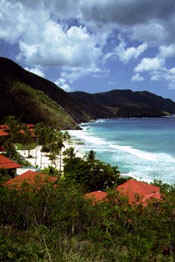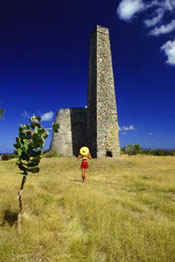St. Croix Travel Guide: Adventures
 |
Best
Beaches: All beaches
on St. Croix are public and free of charge, but if you go to a beach which
is maintained by the resident hotel, you may have to pay a small fee for
facilities. Lying 2.5 kilometers (1.5 miles) off northeast St. Croix, Buck
Island, an 350-hectare (850-acre) national monument, has some of the best
beaches in the St. Croix area, reachable by boat from Christiansted; the
10-kilometer (6-mile) trip takes 45 minutes to an hour. Some
concessionaires who offer sail or motorboat tours also include a picnic
lunch and an overland hike to the island's 125-meter (400-foot) summit
with terrific views. Turtles also lay their eggs on Buck Island beaches.
Cane Bay also has a stunning beach on the island's north side. Other fine
beaches can be found at Protestant Cay, Davis Bay, Cramer Park on the east
shore, and Frederiksted Beach to the north of town. The last two have
changing facilities and showers. Surfing is best on the north coast, and
you'll find great shells on the northwest coast, from Northside Beach to
Ham's Bay, as well as on Sprat Hall Beach.
|
Best Dive Sites: One of St.
Croix's best snorkeling and diving sites is found along Cane Bay on the
island north's shore. On clear days, you can swim out 135 meters (150
yards) to the drop-off and see a "wall" that drops off
dramatically. Various fish and coral are in abundance here. Salt River
Drop-off, at the mouth of the Salt River, is a prime dive location
encompassing actually two sites the east and west walls of a submerged
canyon. The east wall is gently sloping and attracts a huge variety of
marine life; the west wall starts at 9 meters (30 feet) and plunges to a
shelf at 27 meters (90 feet), where it takes a vertical nose-dive to more
than 300 meters (1,000 feet). The wall's caves and deep crevices are
covered with corals and tube sponges and forests of black coral. Fully
equipped dive operators can be found at the Salt River Marina, on the
western shore of the bay, and boats can be chartered for trips into the
mangrove area.
More than 250 species of fish have been recorded at the spectacular
345-hectare (850-acre) island-and-reef system of Buck Island Reef National
Monument, 3 kilometers (2 miles) off St. Croix's north shore, as well as a
variety of sponges, corals, and crustaceans.
Frederiksted Pier has the reputation for being one of the most interesting
pier dives in the Caribbean; its pilings have become an underwater forest
at about 10 meters (35 feet) depth with sponges, plume worms, and great
numbers of tiny yellow, orange, and red seahorses. Snorkeling is also said
to be good. Many hotel properties offer splendid snorkeling sites, as well
as snorkeling equipment. For information on special hotel packages,
contact the St. Croix Hotel Association (Tel. 1-800-524-2026). |
|
Touring the island is quite an adventure,
since it's 82 square miles. Rental cars are available,a and you can also
rent a taxi/tour car and have the guide show you the island. The cost
varies; it depends on the number of hours. Your guide will know where to
take you, what to see, and where to have lunch (which is extra) outside of
town.
Through your hotel you can arrange for a twilight sail or a cocktail
cruise or a Buck Island cookout and much more. Sightseeing tours can also
be arranged through your hotel. Ask for literature to find the range of
programs offered.
St. Croix Travel Guide: St. Croix Adventure Sites
 |
|
Estate
St. George Botanical Garden: Consisting of lush woods and
rich land, the Garden covers 16 acres and contains ruins of a 19th-century
sugarcane village and rum factory including workers' homes, manager's
house, a bake oven, stone dam, a blacksmith's shop and foundations of a
watermill. A small admission fee is charged.
Buck Island Reef: Here
is the only United States National Monument (we call it a "National
Park") that is underwater. The Park itself covers over 850 acres
including the island proper, with a sandy beach, picnic tables and
barbecue pits. The reef has two major underwater trails -- Turtle Bay
Trail and East End Trail. Numerous boats operate off the dock in
Christiansted; your hotel has specifics. Buck Island is just one of St.
Croix's natural wonders. The island is also famous for its beautiful
beaches, including Rainbow Beach and Cane Bay.The Salt River Bay
National Historical Park and Ecological Preserve is a pristine and
historically significant site; Christopher Columbus landed here in
1493. |
The St. Croix Environmental Association (SEA), an organization
committed to the conservation and preservation of St. Croix's natural
wonders, provides articles, lectures, workshops, and field trips on Salt
River Bay.
The SEA is instrumental in preserving other parts of the island as
well. An anonymous benefactor helped the SEA purchase 60 acres of land at
Southgate on the island's east end to preserve a prime nesting wetlands
habitat for birds and endangered sea turtles. 96 bird species have been
recorded at the site, including 26 that are considered threatened or
endangered in the territory.
Studies by the Buck Island Reef Hawksbill Sea Turtle Research Program on
St. Croix have contributed significantly to both the survival of the
endangered Hawksbill Sea Turtle and the study of environmental sciences in
St. Croix's local communities. Begun in 1988, the research program studies
the migration of sea turtles after nesting season and the development of
non-lethal methods for determining the gender of sea turtle hatchlings.
Volunteer assistance from the community has been essential to this
program's success.
Cramer Park: A very nice
place to relax the day away during the weekdays. The Park has a beautiful
beach and picnic area. On weekends the park is transformed into a outdoor
bar atmosphere with DJ's and music.
Cruzan Rum Distillery: Out
on West Airport Road you can visit the distillery and see them making
Virgin Islands rum. The tour includes a walk through the plant by long,
flat sections of kegs, up ramps past the distilling, through fumes as
intoxicating as the rum itself, to bottling and labeling. Check at your
hotel for visiting hours.
Eastern End of the Island:
You've gone as far as you can go in the United States on the easternmost
point of St. Croix, Point Udall. The spot is barren, but beautiful. Bring
your camera.
"Eye to the Sky":
Less than a mile from Point Udall, the National Science Foundation has
funded the installation of a giant $5-million-dollar antenna -- 82 feet in
diameter. This 260-ton dish will be used to explore the unknown universe.
Visit the site, where guides will explain that the antenna is identical to
nine others around the U.S. Together, the ten make up a single radio
telescope, sharing their data over the Internet.
Rain Forest: As you head
towards Frederiksted, you'll come upon Creque Dam Road and the 15 acres of
the Rain Forest. The dam itself is 150 feet high. You will also go along
Mahogany Road, which is lined with beautiful mahogany trees, yellow cedar,
and Tibet trees (also called "mother's tongue" because of the
pods that rustle in the wind). The air is filled with the scent of many of
our island fruits, and also the call of mountain doves. The Forest is
private property; the owners have graciously consented to let visitors
tour.
St. Croix Leap: Also in the
Rain Forest, you will find a group of talented woodcarvers. You can order
wood sculptures and chairs and tables all made from local mahogany and
have them shipped to your home.
Salt River: Here's where
Columbus first arrived in the Virgin Islands in November 1493 on his
second voyage to the New World, with 17 ships and 1500 men. He called this
island Santa Cruz.
Whim Greathouse: A
restoration of one of the finest greathouses from the late 1700s. There's
the main house, windmill, watch house and bathhouse, cookhouse and
apothecary; also a museum and gift shop. This is one of St. Croix's
showplaces. Small admission fee.
In Christiansted: Christiansted
has been called the picture-book harbor of the Caribbean; a natural reef
just offshore assures a haven for yachts and smaller pleasure craft. A
Historical Tour of Christiansted Ask for the "Walking Tour
Guide" at the Division of Tourism. Be sure to bring your camera!
Fort Christiansvaern: Built
in 1774 to protect the town's harbor, the handsomely restored Fort has
battlements to photograph and dungeons to visit. Small admission fee.
Government House: Impressive
and imposing, a beautiful example of Danish architecture, this structure
dates back to 1747. You can go inside, and walk up the majestic staircase
to the magnificently appointed Ballroom.
Outdoor Market: If you're
putting together a picnic, here's the place to visit. The people of the
island bring their fruits and vegetables to sell here. You can get mangos,
papayas and many other delicious things.
Steeple Building: Here is
where you'll find a small museum of Arawak and Carib artifacts, and a
display on the workings of a sugar plantation. There also is an
interesting chronology of the African people's history in the Virgin
Islands; and the history of the diverse architectural styles throughout
the centuries. The Old Customs House is being used as an Art Gallery for
art exhibits all year round.
Churches: You'll also
want to visit some of the lovely old churches in town, including the
Gothic St. John's Anglican Church and the huge Moravian Church (the oldest
of their sect under the American flag).
In Frederiksted: Here's
where many cruise ships dock, approaching the palm-fringed town from the
open sea. Frederiksted is known for its continuous shoreline.
Fort Frederik: The first
foreign salute to the U.S. flag was given at Fort Frederik in 1776. At the
Fort on July 3, 1848, Governor General Peter Von Scholten emancipated the
slaves in the Danish West Indies. The Fort has been restored in brick red
and white, to the way it looked in 1840; the Fort actually dates back to
the 18th century. The restoration includes the courtyard, the stables, the
old soldiers canteen where tobacco and beer were purchased, and the old
garrison, is an art exhibit area. Open daily Monday through Friday.
The Old Danish School: In
the middle of Prince Street, it was designed by the well-known Danish
architect Hingleberg in the 1830s.
St. Patrick's Roman Catholic Church:
At the corner of Prince and Market Streets, it was built of coral stone in
1842.



St. Croix Main Page
 St. Croix
Adventures St. Croix
Adventures  Pack
and Go Pack
and Go  St.
Croix Photos St.
Croix Photos  Map of the Island
Map of the Island
 LukeTravels.com Home
LukeTravels.com Home  Puerto Rico Travel Guide
Puerto Rico Travel Guide
 Contact Us
Contact Us
 ADVERTISE HERE
ADVERTISE HERE
 Add Text Links
Add Text Links

|



